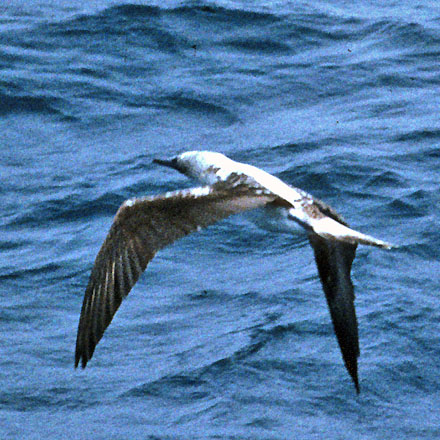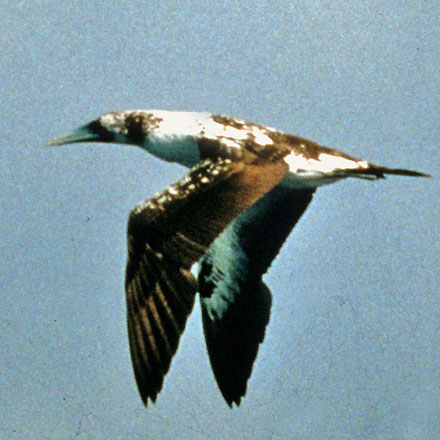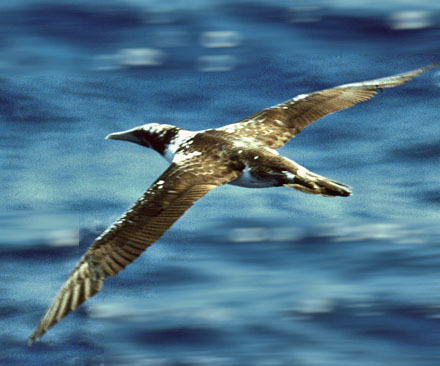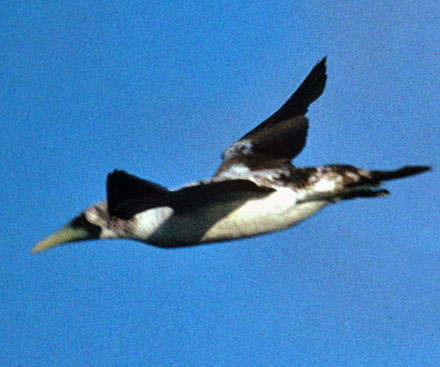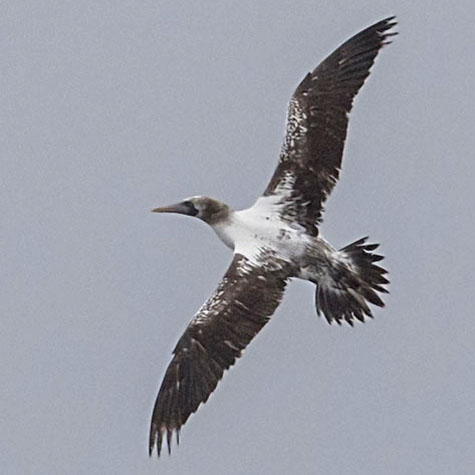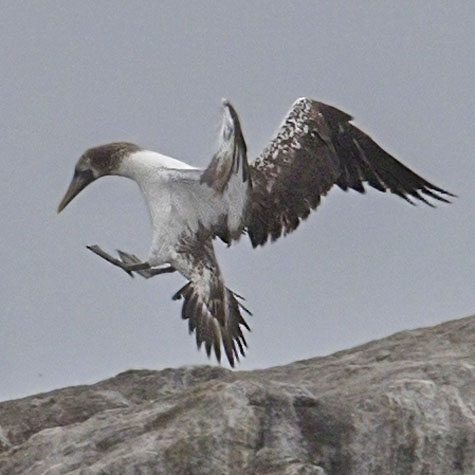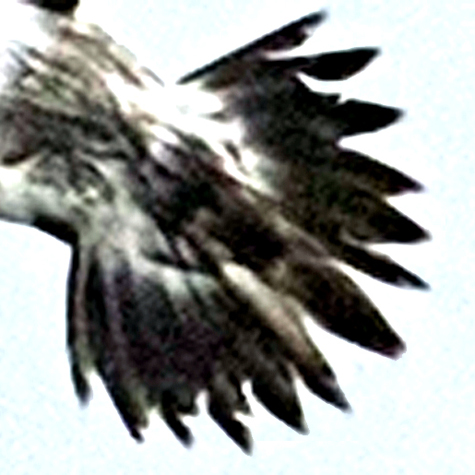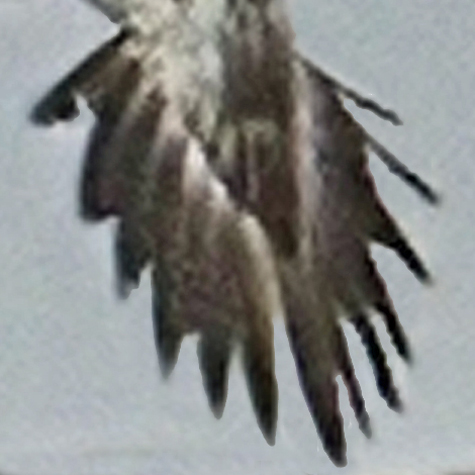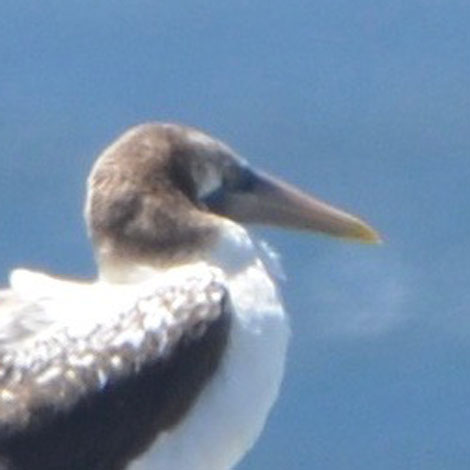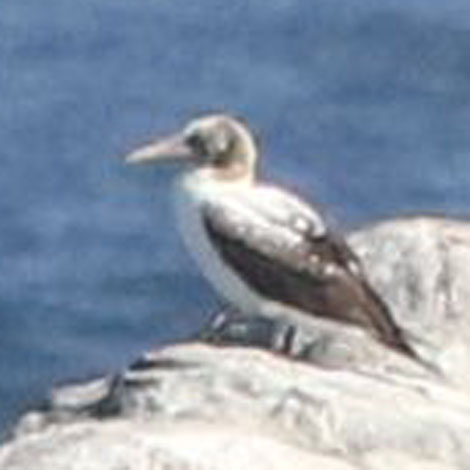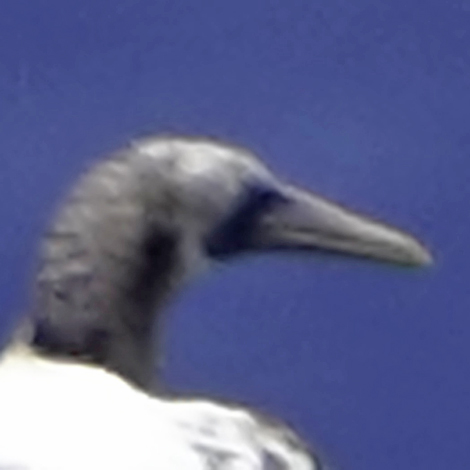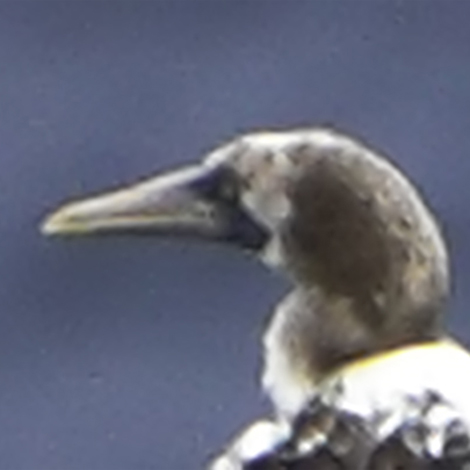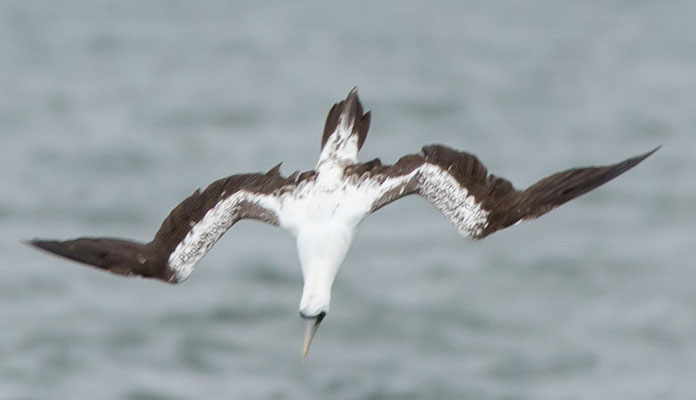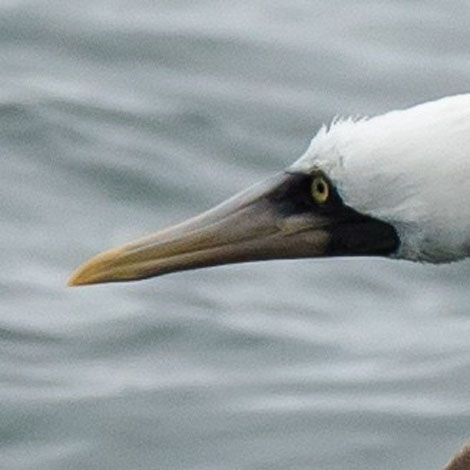[now updated with additional comments; see bottom of page]
a web page by Don Roberson |
 |
||||
Slash had a "usual" roost, shown above — at the far west end of the outermost roosting rock at Pt. Pinos — but it has also roosted on the taller part of that islet which is at the right end of this photo (©D. Roberson). The rock is inaccessible from shore. Many of us have tried digiscoping from shore; this one (right) is a particularly successful effort from 18 July (© Fred Hochstaedter). Nazca Booby Sula granti, an endemic of the Galapagos region in the eastern tropical Pacific, was split from the pan-tropical Masked Booby S. dactylatra after research showed assortative breeding, genetic divergence, with plumage and bare part coloration differences; Jehl & Pitman (1998). Slash is clearly one of these species, but which one? Adults are separated primarily by bill color (Pitman & Jehl 1998, Roberson 1998, Howell et al. 2014) but there are other characters of some value, such as the tendency of adult Nazca to possess mostly white central rectrices (Pitman & Jehl 1998, Roberson 1998; the latter suggested that the tendency, based on a review of 33 photos, was 60%-40% white-tailed but others suggest the white-tailed tendency is greater than that (S. Walens, in litt., A. Jaramillo, in litt.). |
||||
On
18-19 July, Bill Hill obtained some remarkable flight shots (given the
distance involved), four of which are shown below (© Bill Hill).
These show that the subadult booby appears to be just completing its
first-cycle of the accelerated stepwise molt pattern present in boobies
(see Howell et al., 2014, p. 37). In such a pattern there are waves of
molt with periods of suspension, leading to a stepwise pattern of newer
and older feathers. In the photo below left, first row, note the new
(black) outer 3 primaries on right wing contrasting with older
(browner) inner primaries. Howell et al. (2014) describe the first wave
as starting at 6-8 months of age, reaching p6-p8 before suspending,
then a second wave at about 14-16 months of age, sometimes before first
wave suspends. The outermost primaries (p9-p10) are replaced to
complete the first wave while p1-p6 are being renewed in the start of
the second wave. Assuming I am applying the criteria correctly, this
booby appears to be in early second-cycle. At this age (about 1.5 years
old) there can still be some juvenal feathers retained. |
||||
|
||||
Obviously there is substantial body molt also underway at 1.5 years old, with new white feathers replacing brown juvenal-plumaged body feathers across the head, neck, back, rump, and wing coverts. Slash has very extensive white on the underwing coverts but much brown remaining in the upperwing coverts and on the rump. Compare our booby Slash (above) with these photos of similar-aged boobies in the eastern tropical Pacific (below). The upper left booby on the first row below is a Nazca Booby (from the Galapagos on 24 Sep 1989); the other 3 are Masked Boobies taken at various locales southeast of Hawaii on 5-7 Sep 1989 (all © D. Roberson). You can get a feeling of the yellow to yellow-green color of the bills of Masked Booby at this age. The Nazca does show a white central rectrix on this individual in late September. |
||||
|
||||
| Let's move on to specific details. Two more remarkable photos of Slash were taken by Beth Hamel on 20 July (below © Beth Hamel). They provide an excellent opportunity to study the tail pattern of "our" booby in detail. For one thing, one can count the number of rectrices. Masked and Nazca Boobies have 12-16 rectrices (Grace & Anderson 2009). Rectrices always occur in pairs, so the choices for any bird would be 12 or 14 or 16 rectrices. Our booby Slash has 13 rectrices. This means one is missing and likely just starting to grow in. | ||||
|
||||
| To look at the tail in more detail, I enlarged these photos and added contrast, which more easily lets us look at the dark and white areas (below) | ||||
|
||||
We can see that it looks like these rectrices are pretty worn. This could be consistent with still-retained juvenal rectrices (A. Jaramillo, in litt.). It is one of the central rectrices that is missing. We probably can see the tip of the new rectrix growing in just slightly left of the base of the one current central rectrix, especially in the second photo (above right). We can see that the very base of many (all?) of the rectrices is white. Pitman & Jehl (1998) had this to say about tail differences between adults OB [orange-billed = Nazca] and YB [yellow-billed = Masked] boobies in their study:
Of course all this applies to rectrices that are second-cycle or older; juvenal rectrices are all-dark in both species. [Also, according to Pitman & Jehl, some small minority of Masked tails will have white centrals, while some percentage of Nazca tails will be all-dark. There is a photo of a pair of Nazca from Tower Island, Galapagos, in Nelson (1978) that shows one dark-tailed Nazca paired with another Nazca with white central tail feathers. So tail pattern is not a "diagnostic" character — just a helpful one.] If Slash still has 13 juvenal rectrices, it doesn't help us identify it at all! We would need to hope Slash stayed for months and molted in both central tail feathers. And even then .... So let's step away from tail pattern and move on to bill color. Howell et al. (2014) says that in the first-cycle Nazca has a bill "pale greenish gray to greenish yellow; age unknown at which pinkish or orange tones appear on bill base, but probably late in 1st cycle (study needed)." Roberson (1998) says that "juvenal boobies have dull gray or bluish bills" but as subadults the color changes towards adult condition: "Masked Boobies have quite greenish-yellow bills by the time they appear 'half-and-half' dark and white [in body plumage] while the orange or pinkish-red of Nazca Booby should be apparent on the basal half of the bill." Our initial impression in viewing Slash through a scope was that the distal two-thirds of the bill was yellow but the basal third was some pale, dull, non-yellow color, described variously as "ivory" or "bone" or "dusky-chalk." Here are over-enlarged photos taken at different times over 4 different days by 3 different cameras, and showing both sides of the bill. These are all unadjusted for color or saturation [top row, left, backlit on 18 July © Cooper Scollan, who walked out farther on the rocks at low tide to get closer than most of us ever got; top row, right, direct sunlight on 21 July © D. Roberson; bottom row, photos on 19-20 July © Bill Hill]. |
||||
|
||||
You can see the black or blackish bare facial skin for which the original "Masked Booby" was named; some see a blue or dark purple tinge to that bare skin. You can see the yellow eye on at least two of the photos. You can see a bill whose outermost (distal) half or two-thirds is a shade of yellow and a basal half or third that is another color. In general, we would expect a Masked Booby to be yellow, greenish-yellow, or (sometimes) bluish at the base of the bill. We would expect Nazca to be orangeish, pinkish, or dull rose at the base of the bill. I suspect that different folks will use different terms for that part of the bill. Finally, Pitman & Jehl (1998) discussed some other differences between Masked and Nazca Boobies which they called, respectively, YB ("yellow-billed") and OB ("orange-billed") in their paper:
They go into further depth on bill shape differences in their paper. To my eye, a small but perceptible 'dip' in the culmen of Nazca occurs about two-thirds out to the tip, and the bill narrows at that point, providing a different bill aspect than the more straight-culmened heft of Masked. It is a bit subtle and there is likely to be overlap, so it is more of a suggestive point, similar to the tail topic. |
||||
UPDATE: Our Pt. Pinos booby ["Slash"] was present 18-21 July 2017. Since then three more large boobies in this set were seen in California:
Both the 6 Aug bird offshore San Francisco bird and the San Diego pelagic trip bird had white central tail feathers [less certain on the Golden Gate channel bird]. As set out in the discussion above, white central rectrices are a feature of Nazca Booby. While my photo-based review in Roberson (1998) suggested that at least 60% of adult Nazca Boobies had white central rectrices, Alvaro Jaramillo found on a recent visit to the Galapagos that all the adult Nazca Boobies he saw had that feature, and so did a percentage of younger Nazca. There is evidence (e.g., in Roberson 1998) that a minority of adult Nazca Boobies have all-black tails, but it may be a comparative small percentage. We have been unable to quantify for sure what percentage (if any) of adult Masked Boobies have white central rectrices, although Pitman & Jehl (1998) did state that it was a "rare" feature in Masked Booby. Some observers have concerns about hybrids. Robert Pitman, the primary author of Pitman & Jehl (1998), advised me this year that hybrids are a tiny percentage of Masked/Nazca Booby populations, stating:
With a mere handful of hybrids over a worldwide population in the hundreds of thousands, I consider that possibility to be negligible (and we have no information of the color of rectrices on hybrids, or their survival rates). Accordingly, while an all-dark tail does not rule out Nazca Booby, a booby of this type that has both white central rectrices and an appropriately colored bill should be identifiable as a Nazca Booby. |
||||
|
||||
We turn again to bill color. Please recall that Roberson (1998) pointed out that subadult boobies in this set are yellow on the distal half of the bill but that "Masked Boobies have quite greenish-yellow bills by the time they appear 'half-and-half' dark and white [in body plumage] while the orange or pinkish-red of Nazca Booby should be apparent on the basal half of the bill." Another way to say this is that subadult Masked Booby has either an all-yellow or a yellow-green bill as a subadult, but that Nazca Booby has a bill that is yellow on the distal half but should be changing towards adult color on the basal third or half. As full adults, a male Nazca has an orange bill, often with a yellow tip, but adult female Nazca has a rosy-red to coral-red bill, again often with a yellow tip (Roberson 1998). Here is, again at below left, Bill Hill's photo of the Pt. Pinos booby, enlarged to see the bill better (© Bill Hill). I see a bill with a yellow distal half and a dull chalky-pink color on the basal half. At below right is Chris Hartzell's photo of the S.F. booby of 6 Aug — the bird that is a more advanced subadult than the Pt. Pinos booby (© Chris Hartzell) — whose bill is yellow on the distal third but the basal two-thirds appear to me to be a dull rosy-pink. I believe that such a bill pattern is diagnostic of Nazca Booby.
If the S.F. booby can be identified as a Nazca Booby by a combination of tail pattern and bill pattern, could the Pt. Pinos bird be identified on bill color alone? Maybe. It certainly seems to be more likely a Nazca Booby based on the pale rosy tone to the basal half of the bill. At this point in time (Oct 2017) there is no consensus that subadults can be identified by bill color alone — although I would say that if the bill was entirely bright yellow-green at this age, as shown by some of the photos of subadult Masked posted above — then it should be a Masked Booby. Here, on "Slash," I am of the opinion that the bill color is consistent with Nazca at that age. And that's about all we can do at this point in time. Further research should make more progress on this topic. |
||||
Literature cited:
I am grateful to Stan Walens, Alvaro Jaramillo, and Mark Kudrav for discussions on this bird; to all the photographers for use of their images; and to Rita Carratello for editing out some mistakes and typos (but if you find another, let me know!). |
||||
Photos: All photos © Bill Hill, Beth Hamel, Cooper Scollan, Fred Hochstaedter, Blake Matheson, Chris Hartzell, and Don Roberson, as credited; all rights reserved. |
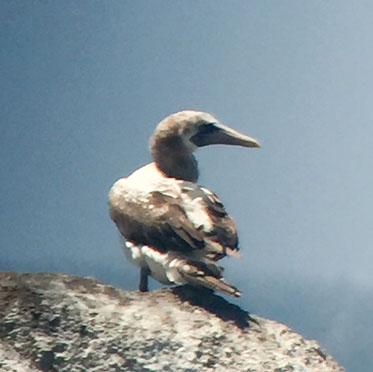 Mark
Kudrav discovered this subadult Masked/Nazca Booby while seawatching on
Tuesday, 18 July 2017. He watched it fly in off the ocean and land on
the outermost roosting rocks at the tip of Pt. Pinos, Monterey Co. This
page is being developed during Days 3-4 of its visit. We now call it
"Slash." This project is to present some photos of Slash and compare
them with at- sea photos of known-identity boobies of a similar age.
Mark
Kudrav discovered this subadult Masked/Nazca Booby while seawatching on
Tuesday, 18 July 2017. He watched it fly in off the ocean and land on
the outermost roosting rocks at the tip of Pt. Pinos, Monterey Co. This
page is being developed during Days 3-4 of its visit. We now call it
"Slash." This project is to present some photos of Slash and compare
them with at- sea photos of known-identity boobies of a similar age. 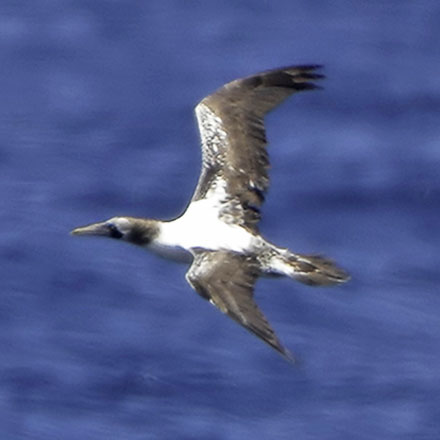
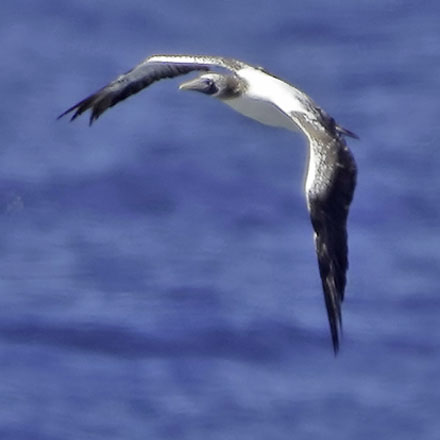
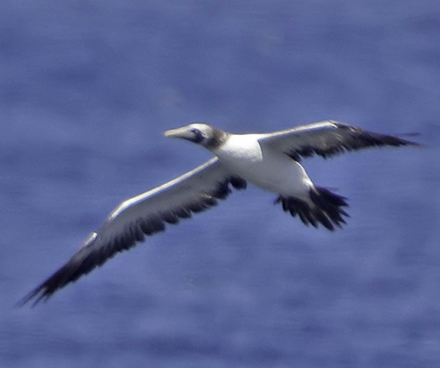

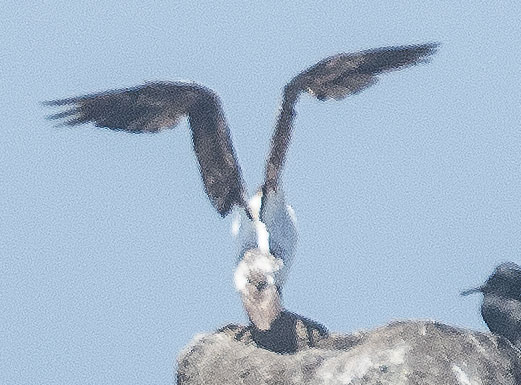 The
above molt discussion dealt with wing molt. A further shot (right) also
confirms the fresh black look of the outermost 3 primaries, and
presumably ageing this bird as early second cycle (© Blake
Matheson).
The
above molt discussion dealt with wing molt. A further shot (right) also
confirms the fresh black look of the outermost 3 primaries, and
presumably ageing this bird as early second cycle (© Blake
Matheson). 